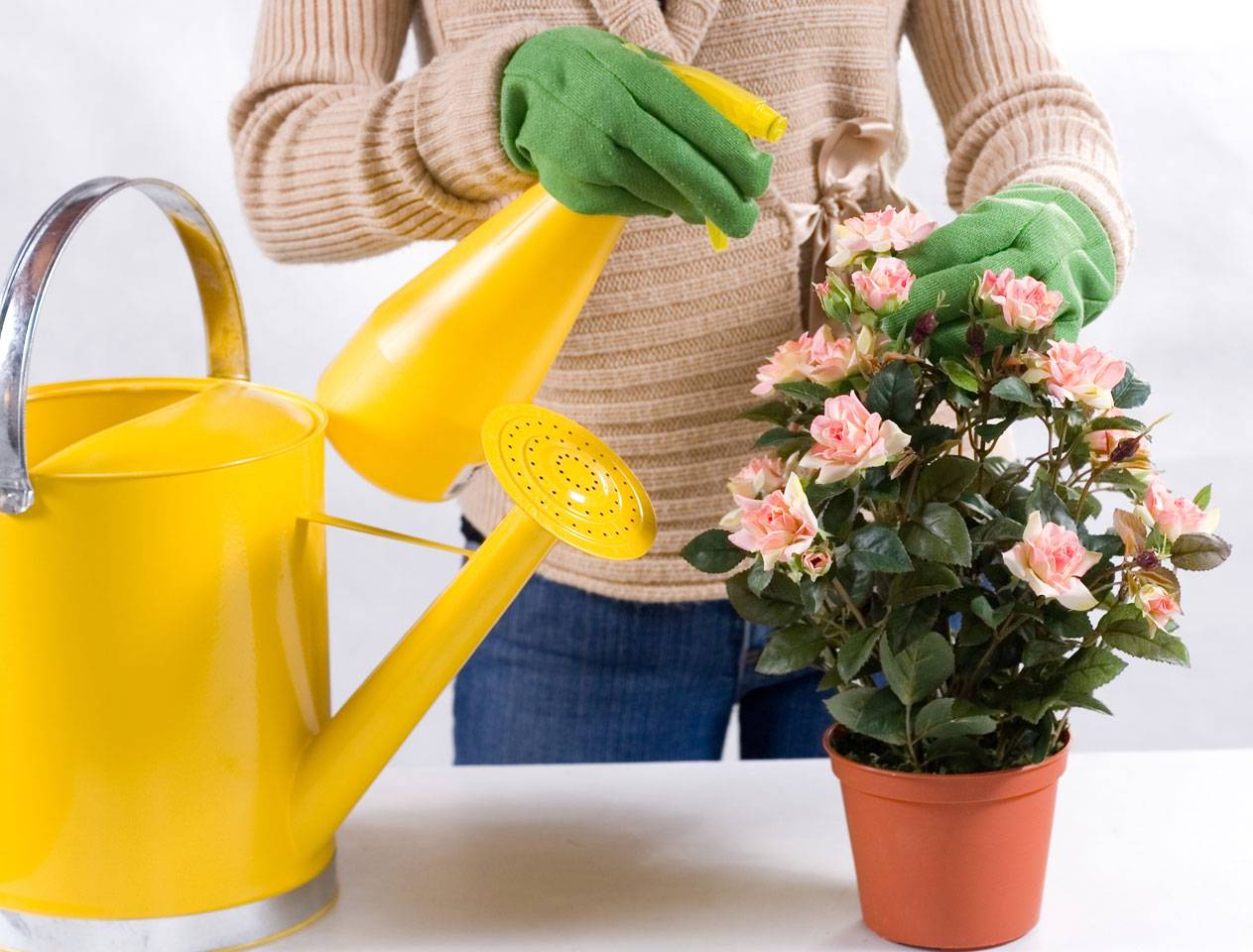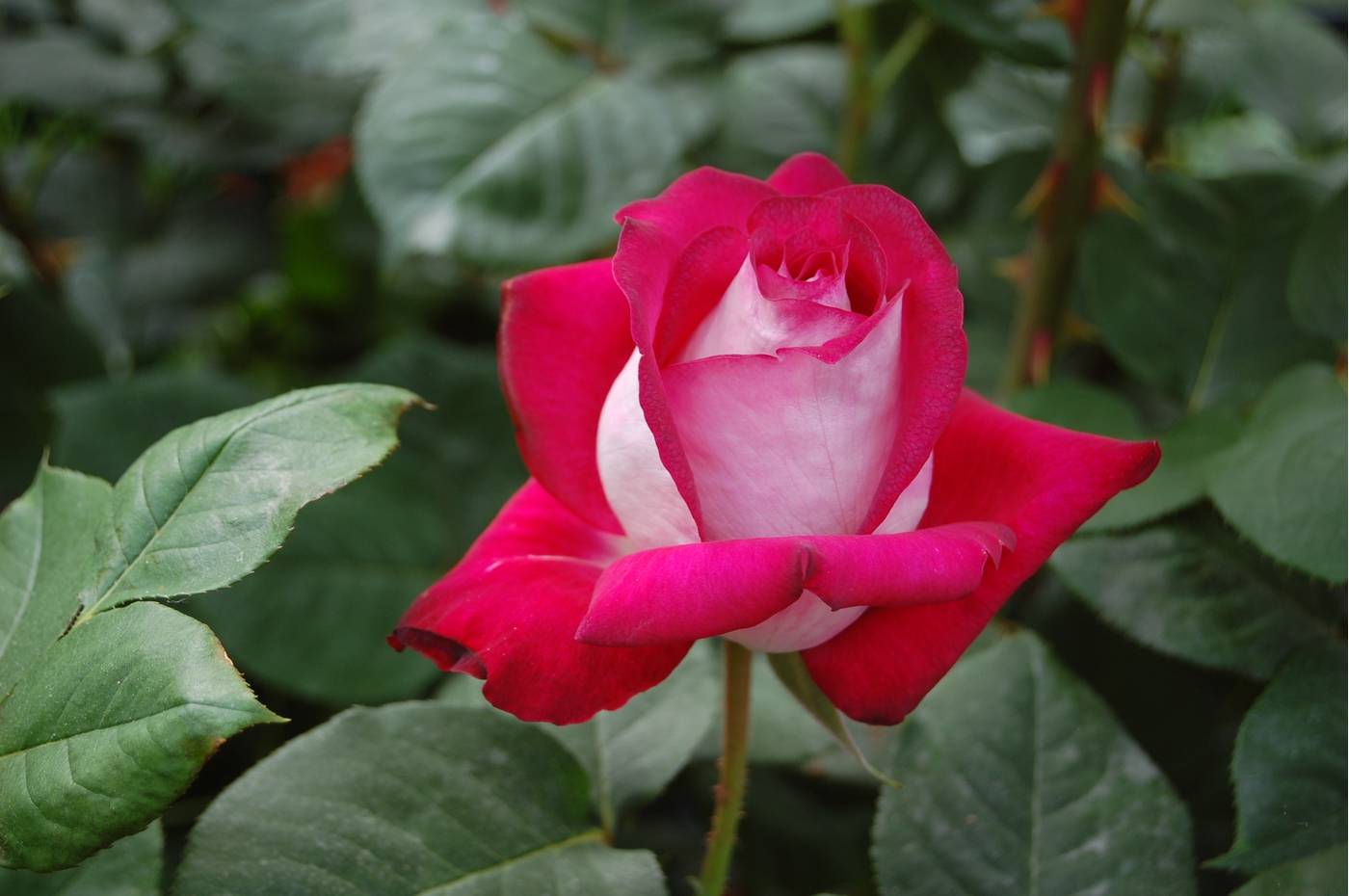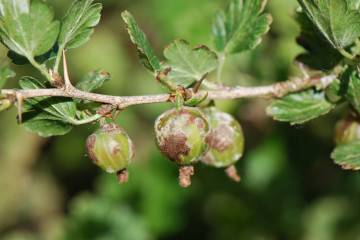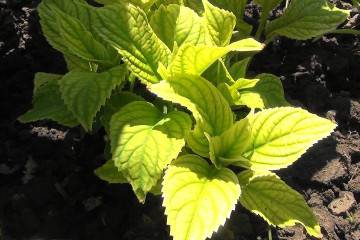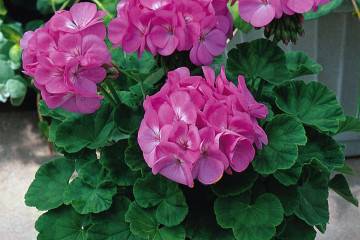Powdery mildew on roses - how to treat, means
Content:
Powdery mildew affects both flowers growing in the open field and domestic ones. It is important to notice the onset of the disease in time to help the plant recover. It spreads rapidly, inattentive growers risk losing the flower if they do not immediately start treatment. You can get rid of powdery mildew on roses both by folk methods, which are effective at the initial stage, and with the help of chemicals.
What is powdery mildew
Indoor plants, like flowers that live in summer cottages, are susceptible to various diseases. Powdery mildew makes roses unattractive, which is reflected in the appearance of buds and leaves. Under the influence of fungi, the plant begins to wither and wither. If you do not react in time and take action, the rose will die.
Favorable conditions for the development of the disease
Powdery mildew is a dangerous disease. The sooner you start treating it, the more chances you have to save the plant. Do not leave the affected parts of the flower, even if it turns out to erase the whitish bloom with your finger.
Powdery mildew on roses appears under the influence of the following factors:
- excessive humidity in the room. If the flower is on the street, then the stifling weather, which often happens before the rain, contributes to the spread;
- lack of fresh air, stuffiness in the house. This does not mean that you need to place the flower in a draft, it is enough to ventilate the room in a timely manner;
- sudden temperature changes, for example, it is too hot during the day, but at night it becomes quite cool;
- excess fertilizers containing nitrogen. Thanks to such feeding, the leaves grow very quickly. The rose develops lush greenery. Powdery mildew primarily affects young leaves. They have not yet had time to get stronger, therefore they are susceptible to various diseases;
- excessive watering. It is important to avoid stagnation of liquid at the roots of the plant. The topsoil should dry out completely. It is also dangerous to skip watering. They should be regular. If the earth dries up and becomes too dense, and then it is watered abundantly, the plant's immunity will suffer greatly, which will undermine its resistance to diseases, in particular, powdery mildew;
- cool weather. If the plant is on the balcony or on the street in summer, then the temperature of 16-19 ° C is considered uncomfortable for it.
What is the danger of powdery mildew
Powdery mildew kills the plant. You cannot ignore its appearance, hoping that the rose itself will cope with the fungus. You can get rid of it only by starting treatment, using folk remedies or special drugs.
A diseased rose becomes unattractive, the disease affects not only the leaves, but the stems and flowers. The plant withers, stops developing, the leaves darken and eventually fall off.To prevent this, you need to periodically inspect the flower, looking at both sides of the leaf. At the first signs of the disease, it is necessary to begin treatment.
Signs of powdery mildew in roses
It is not difficult to recognize a disease that is fraught with danger for a rose. External signs will make it clear that the flower is infected with powdery mildew:
- white bloom appears on the leaves and stem. It is voluminous, slightly fluffy, resembling scattered flour from a distance. Observed on both sides of the sheet. At the onset of the disease, it can be cleaned with a finger;
- drops of water appear on the surface of the leaves. Hence, the disputes began to ripen. This is the next stage of the disease;
- leaf plates and stems are covered with brown spots. This is how matured disputes look like. If you move the plant, you will see how they scatter to the sides. At this stage, chemical treatment is required, there is a risk that it will not be possible to overcome the disease.
In a few days, spores of the fungus can spread throughout the plant and even shrubs if the rose grows outside. In the latter case, the flower should not be allowed to winter in this state. It will not cope with harsh weather conditions even with proper cover. In this state, the rose will die before it reaches spring.
How to deal with the disease
You need to get rid of powdery mildew as soon as possible, without waiting for drops resembling dew to appear on the leaves. You cannot waste time postponing treatment procedures. At the initial stages, you can use folk methods, they are also suitable for the prevention of not only powdery mildew, but also other diseases.
Treatment with folk remedies
The easiest and most affordable method to overcome the powdery mildew that has overcome an apartment flower is soda. In 1 liter of water, dilute 1 teaspoon of powder. Add a little soap shavings to the solution. This will allow the medicine to stay on the leaves and stick to them. The tool needs to process the flower, while capturing not only the affected areas. It is necessary to spray not only the leaves, but also the stems. It is enough to carry out the procedure every 7 days.
Disinfects the plant, potassium permanganate increases its immunity. For 1 liter of water, you need very little powder so that the liquid is slightly colored. The resulting solution can be watered and sprayed.
Preparations for indoor plants
If the disease has already captured the entire plant, and even more so the spots have become dark, then it is necessary to use fungicides.
There are agents that remain on the surface of the flower and act on microorganisms when they come into contact with them. They are called contact. Therefore, it is so important to apply the medicine to all parts of the plant, including the back of the leaf. Other drugs penetrate the sap of the flower and thus attack the fungi. Such drugs are called systemic:
- topaz. It is usually used to treat garden plants, but it has an effect in home use as well. It is important to follow the precautions indicated on the package and prepare the solution according to the instructions. Of course, 10 liters of solution will not be needed for an indoor flower, so you need to reduce the dosage, observing the proportions. The drug has many positive reviews, since after its application, light spots do not remain on the leaves and stem. It is in an ampoule. Before the procedure, it must be opened and the required amount must be taken with a syringe;
- thiovitis. It is based on sulfur.It should be taken into account that if the temperature of the water used to dissolve the powder is below 20 ° C, the effectiveness of the drug is significantly reduced;
- fast A well-known universal remedy. It is used for medicinal and prophylactic purposes.
Color processing rules
For effective treatment, it is recommended to use freshly prepared solutions. This is especially true for chemicals. All affected parts of the plant must be removed before the procedure. We'll have to cut off wilted buds, deformed leaves. If there are other plants nearby that have not yet been affected by fungi, they must be transferred to another place, treated for prevention.
It is necessary to apply medicinal solutions on the sheet from both sides, not forgetting about the stem. This is especially true for drugs that have a contact effect. During the period of illness, it is necessary to exclude any feeding and spraying with water. One application of the medication is not enough to get rid of powdery mildew. You will have to return to the wellness procedure again, usually it is repeated after a week.
When working with chemicals, care must be taken to protect the skin and mucous membranes. At the very least, it is necessary to wear gloves, it is better to use a protective mask, glasses. Clothing should cover arms and legs. After work, the preparations must be removed to a dark place, making sure that children and animals do not get them.
Folks capable of controlling powdery mildew work well at the onset of the disease. They will not only heal the rose, but will strengthen its immunity, give strength for growth and development.
Prophylaxis
To prevent powdery mildew infection, you need to adhere to the following recommendations:
- establish an irrigation regime. Make sure that the top layer of the soil dries out. Watering earlier is not worth it, otherwise the liquid will begin to collect at the roots, they can rot;
- use drainage, which must be placed on the bottom of the pot. Expanded clay, broken brick, pebbles are suitable. This will also help prevent waterlogging of the soil;
- avoid a sharp jump in temperatures;
- provide the plant with access to fresh air;
- periodically inspect the rose, noticing any changes, in particular, spots, plaque. Pay attention to neighboring plants, if necessary, isolate diseased specimens;
- feeding a rose, adhere to a certain balance. You do not need to be zealous with nitrogenous fertilizers, which contribute to the rapid growth of fresh greens. Roses also need potassium and phosphorus. During the period of illness, when the plant is weakened, it is better to remove any feeding. You need to return to them as you recover;
- you can not touch a healthy plant after processing a patient. You need to wash your hands thoroughly, because spores are carried with them in the same way as with water, through the air.
Powdery Mildew Resistant Roses
Some varieties of roses are immune to fungal diseases, in particular to powdery mildew. Even if nearby plants have suffered, they remain healthy and continue to delight with their colorful blooms. Among them:
- Aphrodite. Differs in large pale pink flowers, they reach 12 cm in diameter;
- Gold spice. It blooms for a long time, the buds are semi-double, small, peach-yellow;
- Galaxy. Medium-sized creamy yellow flowers. They are pale yellow, have a pink edge;
- Nostalgia. The rose is pale pink in color and has a pleasant scent. The edges of the petals are of a more saturated shade;
- Scrub Rococo.The rose resembles a rose hip due to its open core. She has a strong scent. The blossoming buds are huge, exceeding 18 cm;
- Monica Bellucci. Large buds grow up to 16 cm in diameter. Inside the petals are bright crimson, outside they are white.
How to recognize downy mildew
Rose leaves and stems can be affected by downy mildew. It is a fungal disease that resembles powdery mildew. In this case, spots appear on the upper side of the sheet plate. They can be yellowish, brownish, purple and even almost red. They gradually change, grow, no longer look like small specks. A yellow border appears. Gray spots with a fluffy bloom are visible on the lower part of the leaf. If the disease is not stopped, they begin to wither, turn black, curl and fall off. Flowers and buds also change. They stop growing, become faded, the petals located outside turn black and dry. They must be removed immediately to save the rose. It is better to save the strength of the plant so that you do not have to spend it on the restoration of leaves and buds, which will not work out to normal.
Downy mildew resembles black spot, but diseases can be distinguished. In case of peronosporosis, the rose becomes covered with spots, starting from the upper leaves, gradually they spread below. In this case, the plant withers quickly enough. Several days pass, and the leaves begin to fall off.
It is easier to prevent any disease than to fight it. This also applies to powdery mildew, which can destroy the rose. To exclude fungal infection, you need to organize watering of the plant, provide it with loose soil, balanced fertilization and do not forget about drainage. High humidity and lack of fresh air are factors contributing to the development of powdery mildew. There are folk methods to rid the rose of fungi. They also serve as preventive measures to avoid many diseases and strengthen the immunity of plants.




